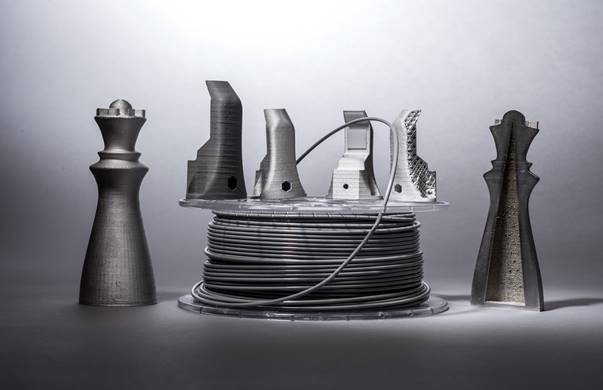Coming out of BASF’s Chemovator business incubator is Replique. The German company is offering a solution to enable the on-demand manufacturing of spare parts. Not only could Replique’s concept be huge, but the fact that it is being backed by the world’s largest chemical company, BASF, has some major significance for additive manufacturing (AM) and industry at large.
Replique notes the spare parts are expensive to produce, store, and get to users, particularly after they are no longer mass produced. To ameliorate this, the company is establishing what it calls “the first industrial, fully encrypted virtual inventory platform for on-demand manufacturing and fulfillment.” Replique is making big promises, as well, saying that it will offer “huge total cost savings and growth opportunities in the aftermarket, almost unlimited global availability of their spares and accessories, rapid local delivery and thus higher customer satisfaction and brand loyalty.”

“In our interviews with over 50 OEMs across all industries, we identified that 66 percent of the OEM spare parts in storage are for appliances no longer in production. Difficulties in demand planning, huge warehouses, as well as high minimum order quantities lead to costly processes in aftermarket management,” Dr. Max Siebert, Co-Founder, stated. “We know that after serial production ends, with traditional remanufacturing and distribution the cost of a spare part increases by up to 20 times. Moreover, it negatively influences the customer experience as delivery times are long.
“Our end-to-end encryption of the OEM design ensures it is far better protected throughout the value chain compared to the complex, often untransparent manufacturing processes of the past.. Further, we enforce strict 3D printing and process parameters for the service bureaus and track them in order to ensure that all parts are printed in the requested quantity and the original OEM quality,” he added. “Replique transforms the substantial expertise of BASF in AM material and digital design optimization into a highly efficient commercial platform. By providing secure storage, manufacturing and fulfilment we couple this with a 21st century service model that adds direct value for OEMs.”
Replique aims to connect 3D printing services, backed by BASF with its experience in AM. This includes prototyping, design optimization, and industry-directed applications for industrial 3D printed components. So, it seems that BASF wants to go from chemistry to polymers to parts.

BASF’s Ultrafuse 316L – Metal filament for 3D printing stainless steel parts
I’ve stated before that it would be interesting to see if companies copy Victrex in going from selling polymers to selling parts. Victrex sells the powerful plastic PEEK, but, for medical, it wants to 3D print you an implant. Such disruptions in the value chain are going to become more commonplace.
In a previous article, we discussed a similar scenario occurring in metals with Sandvik. By selling low-value inputs to customers, materials companies are now tempted to switch to selling high-value products and solutions that use their own inputs to gain a more advantageous part of a value chain or business. If China will commoditize everything, a lot of firms think that they must move up. At the same time, in a more competitive space, friends of old may have just become superfluous. Parts and process businesses, however, are very different animals. So, it will be a leap, but the breadth and depth of BASF strategy is becoming clear. Mitsubishi is also doing something similar with the AddiFab service in molding for spare parts.

BASF makes the precursors, the monomers, the polymers, then enters the filament market, then buys Sculpteo. Now, the German chemical giant is going to be selling and making parts. All the while, it has been looking at manufacturing and how to make better products with 3D printing. Now that they have a complete offering from vat polymerization resins, to sintering powders and filaments, they can tackle many different types of spare parts. Their BASF Ultrafuse filaments will now also be very advantageous to the company as products that can make even more spare parts available to them. Their work with Farsoon and investment in Essentium, point to who the machine manufacturers are, as well.
All and all, it’s a complete and solid play. It presupposes that car manufacturers and other companies will not invest heavily in production and continue to outsource to several tiers of suppliers. If this is the case, then “business as usual” will continue and the company has a bright future in making everyone’s spare parts for them. With its complete vertical integration, the firm will reap rewards and grow. With electrification, however, certain companies could move towards partial production in-house or could decide to do a lot of manufacturing themselves.
In metal printing, for example, GKN now makes powder and has bought services. Oerlikon also makes powder and has a service, as well. And let’s not forget GE, who doubled down on OEMs, services, and a materials business, so it could industrialize parts. It’s conceivable that a car company buys a gas atomization plant, gets SMS Group to build it a factory, and then buys a metal OEM to print parts. If they look at us as a forever technology coupled with the fact that we can optimize their engines, batteries, heat sinks and F1 wins, it makes sense to me. Also because they’d lock themselves into using the same machine OEM essentially forever because they will all build up parts differently.
In polymers, the investments in an OEM and a filament and powder firm would be much less and it may give them an advantage in flexibility and mass customization. It’s really dependent on what the leaders will see for their future role as manufacturing companies. Are we a push-button solution that can optimize all parts and thus represent a strategic play? Or are we just a manufacturing technology to use, like stamping or die casting? If they see it as strategic, then many firms may compete with BASF. But, even then, I think this is a bold move that will see the company really capture a lot of potential business in the future.
Subscribe to Our Email Newsletter
Stay up-to-date on all the latest news from the 3D printing industry and receive information and offers from third party vendors.
You May Also Like
Gorilla Sports GE’s First 3D Printed Titanium Cast
How do you help a gorilla with a broken arm? Sounds like the start of a bad joke a zookeeper might tell, but it’s an actual dilemma recently faced by...
Nylon 3D Printed Parts Made More Functional with Coatings & Colors
Parts 3D printed from polyamide (PA, Nylon) 12 using powder bed fusion (PBF) are a mainstay in the additive manufacturing (AM) industry. While post-finishing processes have improved the porosity of...
$25M to Back Sintavia’s Largest Expansion of Metal 3D Printing Capacity Since 2019
Sintavia, the digital manufacturing company specializing in mission-critical parts for strategic sectors, announced a $25 million investment to increase its production capacity, the largest expansion to its operations since 2019....
Velo3D Initiates Public Offering in a Bid to Strengthen Financial Foundations and Drive Future Growth
Velo3D (NYSE: VLD) has been among a number of publicly traded 3D printing firms that have attempted to weather the current macroeconomic climate. After posting a challenging financial report for 2023,...































